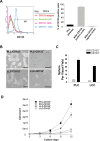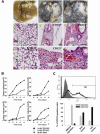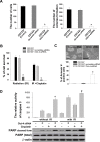Oct-4 expression maintained cancer stem-like properties in lung cancer-derived CD133-positive cells
- PMID: 18612434
- PMCID: PMC2440807
- DOI: 10.1371/journal.pone.0002637
Oct-4 expression maintained cancer stem-like properties in lung cancer-derived CD133-positive cells
Abstract
CD133 (prominin-1), a 5-transmembrane glycoprotein, has recently been considered to be an important marker that represents the subset population of cancer stem-like cells. Herein we report the isolation of CD133-positive cells (LC-CD133(+)) and CD133-negative cells (LC-CD133(-)) from tissue samples of ten patients with non-small cell lung cancer (LC) and five LC cell lines. LC-CD133(+) displayed higher Oct-4 expressions with the ability to self-renew and may represent a reservoir with proliferative potential for generating lung cancer cells. Furthermore, LC-CD133(+), unlike LC-CD133(-), highly co-expressed the multiple drug-resistant marker ABCG2 and showed significant resistance to chemotherapy agents (i.e., cisplatin, etoposide, doxorubicin, and paclitaxel) and radiotherapy. The treatment of Oct-4 siRNA with lentiviral vector can specifically block the capability of LC-CD133(+) to form spheres and can further facilitate LC-CD133(+) to differentiate into LC-CD133(-). In addition, knock-down of Oct-4 expression in LC-CD133(+) can significantly inhibit the abilities of tumor invasion and colony formation, and increase apoptotic activities of caspase 3 and poly (ADP-ribose) polymerase (PARP). Finally, in vitro and in vivo studies further confirm that the treatment effect of chemoradiotherapy for LC-CD133(+) can be improved by the treatment of Oct-4 siRNA. In conclusion, we demonstrated that Oct-4 expression plays a crucial role in maintaining the self-renewing, cancer stem-like, and chemoradioresistant properties of LC-CD133(+). Future research is warranted regarding the up-regulated expression of Oct-4 in LC-CD133(+) and malignant lung cancer.
Conflict of interest statement
Figures







References
-
- Spira A, Ettinger DS. Multidisciplinary management of lung cancer. N Engl J Med. 2004;350:379–392. - PubMed
-
- Hsu HS, Wen CK, Tang YA, Lin RK, Li WY, et al. Promoter hypermethylation is the predominant mechanism in hMLH1 and hMSH2 deregulation and is a poor prognostic factor in nonsmoking lung cancer. Clin Cancer Res. 2005;11:5410–5416. - PubMed
-
- Socinski MA, Bogart JA. Limited-stage small-cell lung cancer: the current status of combined-modality therapy. J Clin Oncol. 2007;25:4137–4145. - PubMed
-
- Bernstein ED, Herbert SM, Hanna NH. Chemotherapy and radiotherapy in the treatment of resectable non-small-cell lung cancer. Ann Surg Oncol. 2006;13:291–301. - PubMed
-
- Lam WK, Watkins DN. Lung cancer: future directions. Respirology. 2007;12:471–7. - PubMed
Publication types
MeSH terms
Substances
LinkOut - more resources
Full Text Sources
Other Literature Sources
Medical
Research Materials

